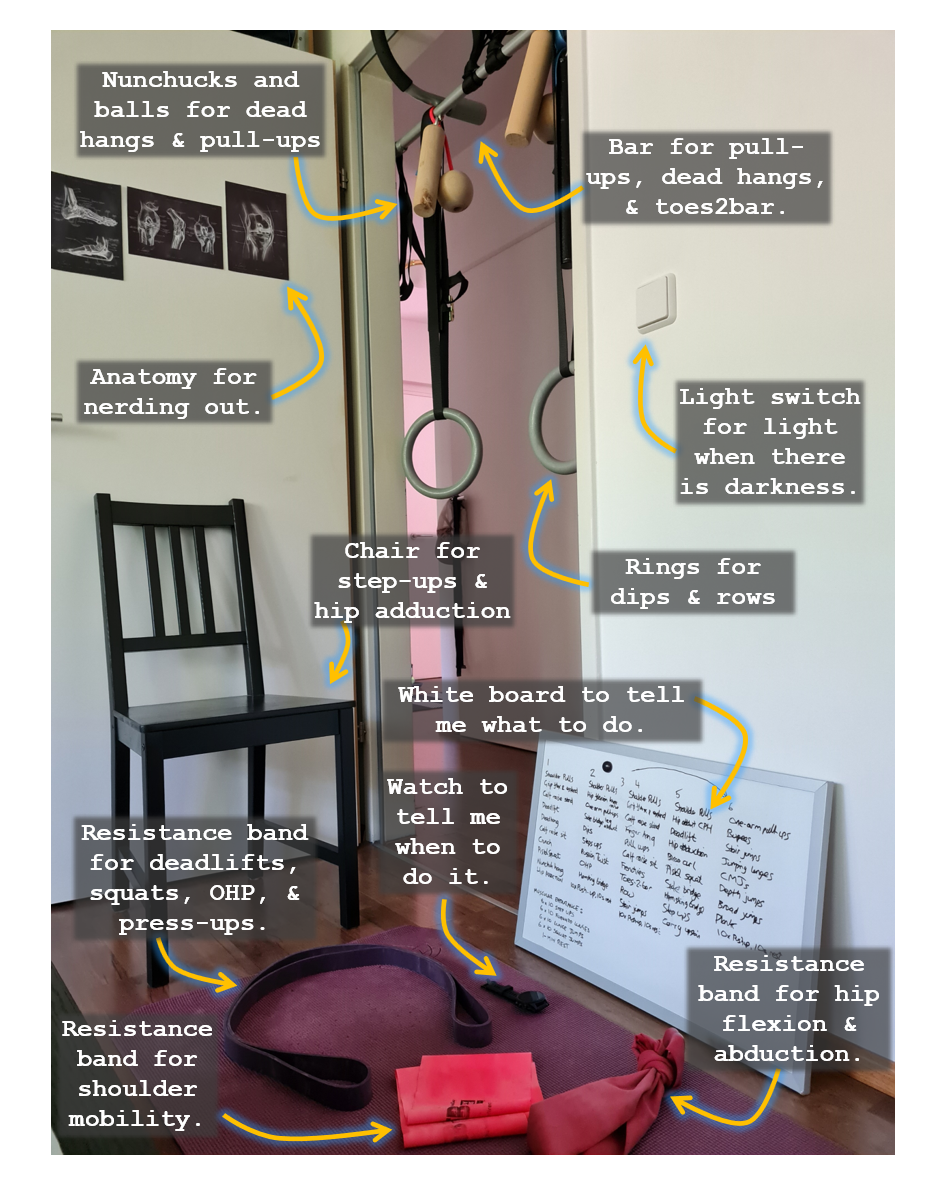
This page is being updated. Check back soon…
Free home gym or hotel room exercises for athletes.
Designed by Thomas Solomon PhD.
During COVID lockdown, gyms were shut, climbing walls were closed, running tracks were out-of-bounds, trails and streets were off-limits or under a curfew, and races were cancelled. Some folks were stuck at home; others were trapped in hotels. Although those restrictions are behind us, sometimes we still find ourselves "stuck" at home or even "trapped" in hotels when on holiday or travelling.
 What do you do when you don't have access to your "normal" training environment?
What do you do when you don't have access to your "normal" training environment?
 What do you do when you can't train properly?
What do you do when you can't train properly?
Don't stress. Regroup. Reorganise your habits.
Here's my home gym... how does yours look?

Get your house in order with my help.
Be creative. Stay on track.

Choose what you want.
(click the buttons)

(click the buttons)
During my time working in Denmark, I helped implement several inactivity studies where healthy active people were forced to reduce their daily step-counts from ~10,000 to ~1500 steps per day for 2-weeks. The good news, in the context of cardiorespiratory fitness, was that following 2-weeks of daily step-reduction, VO2max only fell by ~2 mL/kgFFM/min. Although these studies were not conducted in athletes, fortunately other groups of scientists have addressed that topic. In well-trained cyclists, 21-days of reduced training volume (-50%), frequency (-20%), and intensity (-20% to -30%) had no effect on VO2max. While a further study in world-class kayakers found that, although total training cessation for 5-weeks reduced muscle strength by ~9%, maintenance of low-volume training led to losses of only ~3%. So, fear not. Your loss will be small if you maintain some activity.
|
|
|
|
And, don't be fooled by the simplicity of a step-workout—even Eliud Kipchoge loves a good stair-stepping work-out and uses them as part of his strength-building base phase, including when en route to his "1:59".
This is a free training tool. If it provides you with value, please help keep it alive by buying me a beer:
 Buy me a beer.
Buy me a beer.
 Buy me a beer.
Buy me a beer.
Get free summaries of the latest evidence in exercise and nutrition science.
I will not bombard your inbox with product offers and pointless messages — I hate spam as much as you do! Subscribing to my mailing list gives you first-access to my articles and nerd alert summaries of the latest in running-related exercise and nutrition science. The content is free and designed to help you train smart.
|
|
|
|
|
|
|
|
|
|
|
|
|
|
|
|
This is a free training tool. If it provides you with value, please help keep it alive by buying me a beer:
 Buy me a beer.
Buy me a beer.
 Buy me a beer.
Buy me a beer.
Get free summaries of the latest evidence in exercise and nutrition science.
I will not bombard your inbox with product offers and pointless messages — I hate spam as much as you do! Subscribing to my mailing list gives you first-access to my articles and nerd alert summaries of the latest in running-related exercise and nutrition science. The content is free and designed to help you train smart.
|
|
|
|
|
|
|
|
|
|
|
|
This is a free training tool. If it provides you with value, please help keep it alive by buying me a beer:
 Buy me a beer.
Buy me a beer.
 Buy me a beer.
Buy me a beer.
Get free summaries of the latest evidence in exercise and nutrition science.
I will not bombard your inbox with product offers and pointless messages — I hate spam as much as you do! Subscribing to my mailing list gives you first-access to my articles and nerd alert summaries of the latest in running-related exercise and nutrition science. The content is free and designed to help you train smart.
|
|
|
|
|
|
|
|
|
|
|
|
This is a free training tool. If it provides you with value, please help keep it alive by buying me a beer:
 Buy me a beer.
Buy me a beer.
 Buy me a beer.
Buy me a beer.
Get free summaries of the latest evidence in exercise and nutrition science.
I will not bombard your inbox with product offers and pointless messages — I hate spam as much as you do! Subscribing to my mailing list gives you first-access to my articles and nerd alert summaries of the latest in running-related exercise and nutrition science. The content is free and designed to help you train smart.
|
|
|
|
|
|
|
This is a free training tool. If it provides you with value, please help keep it alive by buying me a beer:
 Buy me a beer.
Buy me a beer.
 Buy me a beer.
Buy me a beer.
Get free summaries of the latest evidence in exercise and nutrition science.
I will not bombard your inbox with product offers and pointless messages — I hate spam as much as you do! Subscribing to my mailing list gives you first-access to my articles and nerd alert summaries of the latest in running-related exercise and nutrition science. The content is free and designed to help you train smart.
This is a free training tool. If it provides you with value, please help keep it alive by buying me a beer:
 Buy me a beer.
Buy me a beer.
 Buy me a beer.
Buy me a beer.
Get free summaries of the latest evidence in exercise and nutrition science.
I will not bombard your inbox with product offers and pointless messages — I hate spam as much as you do! Subscribing to my mailing list gives you first-access to my articles and nerd alert summaries of the latest in running-related exercise and nutrition science. The content is free and designed to help you train smart.
|
|
|
|
This is a free training tool. If it provides you with value, please help keep it alive by buying me a beer:
 Buy me a beer.
Buy me a beer.
 Buy me a beer.
Buy me a beer.
Get free summaries of the latest evidence in exercise and nutrition science.
I will not bombard your inbox with product offers and pointless messages — I hate spam as much as you do! Subscribing to my mailing list gives you first-access to my articles and nerd alert summaries of the latest in running-related exercise and nutrition science. The content is free and designed to help you train smart.



